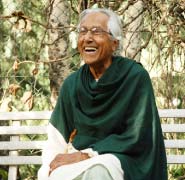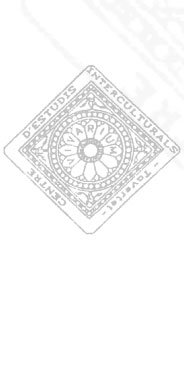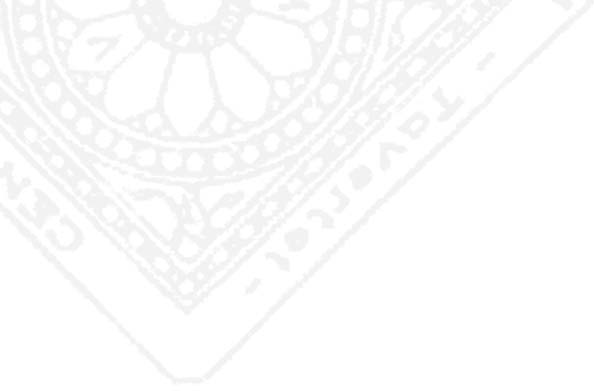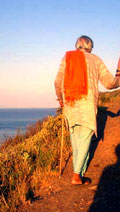



VITAL AND INTELLECTUAL JOURNEYS
4. University teaching in California (1966-1987)
Panikkar began his university career in the United States, without giving up his ties to India. For more than twenty years, from the mid 60s until the end of the 80s, Panikkar divided his life between India and the United States. He taught Comparative Religion as a Visiting Professor at the Universities of Harvard and California, at the Union Theological Seminary in New York, the Center for the Study of World Religions at Cambridge University (England), in Montréal (Canada) and in other countries in America (Mexico, Venezuela, Colombia, Peru, etc.). In 1970 he was appointed as Honorary Professor at the United Theological College in Bangalore. From 1971 until his retirement in 1987, he was based at the University of California in Santa Barbara, where he was a Professor of Comparative Philosophy of Religion and History of Religions.
For another quarter of a century, I have been “commuting” between one of the richest cities of one of the richest states of the most powerful nation in the world and its opposite (twelve hours in time difference away), one of the most chaotic cities of one of the most “underdeveloped” states in one of the poorest countries in the world (disregarding the tiny minority of the rich). I have been commuting between Santa Barbara in California, U.S.A., and Varanasi in Uttar Pradesh, India. In quite a literal sense, my interior life was the only realm common to both hemispheres of life. (“Philosophy as Life-style”, A Dwelling Place for Wisdom)
Panikkar was very prolific in these years, publishing many articles in a variety of journals: Theoria to Theory and Harvard Divinity Bulletin (Cambridge), Communio Viatorum (Praha), Kairos (Salzburg), Aeropag (München), Studia Liturgica (Rotterdam), La Vie Spirituelle (Paris), Salmanticensis (Salamanca), Revista de Occidente y Cuadernos para el Diálogo (Madrid), Orient (Montréal), The Whole Earth Papers (New York), Interculture, The Teilhard Review, Humanitas, Revue Internationale de Philosophie, Monchanin Information, Japan Missionary Bulletin, Concilium, The Clergy Review, Indian Ecclesiastical Studies, Jeevadhara, Indian Journal of Theology, etc. He also contributed book chapters to a number of books.
In this period he published many of his books:
—Kerygma und Indien (Hamburg 1967);
—Offenbarung und Verkündigung. Indische Briefe (Freiburg 1967);
—Técnica y tiempo. La tecnocronía (Buenos Aires 1967);
—La gioia pasquale (Vicenza 1968);
—L’homme qui devient Dieu. La foi, dimension constitutive de l’homme (Paris 1969; includes a debate with E. Castelli, G. Girardi, S. Breton, H. Ott and others);
—La presenza de Dio (Vicenza 1970);
—The Silence of God (Maryknoll 1989; first published in Spanish in 1970, with a Foreword signed in Varanasi, 1967, and Harvard, 1968), one of his key works, published in a completely revised edition as El silencio del Buddha. Una introducción al ateismo religioso (Madrid, 1996, 1999 i 2005; Barcelona 2004), with editions in Italian (1985 y 2006), German (1992 and 1996) and Dutch (2002);
—The Trinity and World Religions (Bangalore, 1970), revised and expanded edition: The Trinity and the Religious Experience of Man. Icon, Person, Mystery (London 1973), with editions in Catalan (Barcelona 1998), Spanish (Madrid 1998), Italian (1989), German (1993), Czech (1999), Portuguese (2001) and French (2003);
—Dimensioni mariane della vita (Vicenza 1972);
—Worship and Secular Man (London-New York, 1973; Culto y secularización. Apuntes para una antropología litúrgica, Madrid 1979);
—Salvation in Christ (California 1972);
—Espiritualidad hindú. Sanatana dharma (Barcelona 2005; Spiritualità indù. Lineamenti, Brescia 1975);
—The Vedic Experience: Mantramanjari. An Anthology of the vedas for Modern Man and Contemporary Celebration (Los Angeles-London 1977), an extensive anthology of the Veda that has been translated into Italian;
—The Intrareligious Dialogue (New York 1978; revised and expanded edition, New York 1999), translated into French (1985), Polish (1986), Italian (1988), German (1990), Indonesian (2000) and Chinese (2001);
—Myth, Faith and Hermeneutics. Cross-Cultural Studies (New York 1979; Italian revised edition: Mito, fede ed ermeneutica. Il triplice velo della realtá, Milano 2000), with editions in German (1990 i 1992), Tamil (2003) and Spanish (2007);
—Blessed Simplicity. The Monk as Universal Archetype, (New York 1982, with a catalan revised edition, Benaurada senzillesa, Barcelona 2000).
*1. An Outstanding Man. Raimon Panikkar’s Fourfold Identity
*3. India. Christian-Hindu-Buddhist symbiosis. Meeting Monchanin and Le Saux (1955-1966)
*5. His return to his Catalan roots to complete his vital cycle
*6. Raimon Panikkar: Writing as a Life-style
